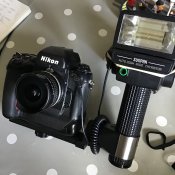Thanks for all the comments, helpful in thinking this through.
Let me clarify - I'm not concerned with coverage, it's the close subject matter and not wanting to use f32. I'd like to have the edges and background 1-2 stops under.
Here's my thinking:
Ambient light = 1/1000 f2.8
or at sync: 1/250 f5.6
Suppose a flash with GN45, film ISO400, subject 1 meter.
Then: aperture = f90. Power reduction by 1/128 = f8.
Am I correct?
F8 for flash with the background one stop under at f5.6 would be ideal I think. So I need a GN45 flash with varipower down to 1/128.
OK, suppose the ambient light is 1/250 at f/5.6. You want to have the background at 1 stop underexposure, thus you want to expose at 1/250 at f/8. To gain correct exposure with the flash, you need to have f/8 at 1 meter at ISO 400, which is nominally a GN of 8 meters at ISO 400, meaning it would have a GN of 4 meters at ISO 100. That is six stops less, or 1/64 power, from a GN of 32 meters (100 feet) at ISO 100, which is a pretty common flash power.
It's easy to find a flash that has settings of manual 1-1/16 power, but a little harder to find 1/64. I think the Nikon SB-26 and SB-28 can do manual 1/64 power. Another option is to find a flash that has an auto mode (not TTL, just A mode) that lets you do f/8 at ISO 400 as close as 1 meter. Also, you could set the flash to its widest setting or use a diffuser like a Sto-fen or mini softbox, which should be good for losing a stop or so. Anyway you do it, you'll want to run some tests.
(I'm ignoring that the subject's face will get full exposure from the flash plus 1/2 from the ambient. You could dial the flash down a fraction of a stop to compensate, but I don't think it's a huge problem, especially if the subject is facing down toward you and getting less light from the sky.)











